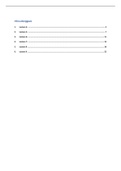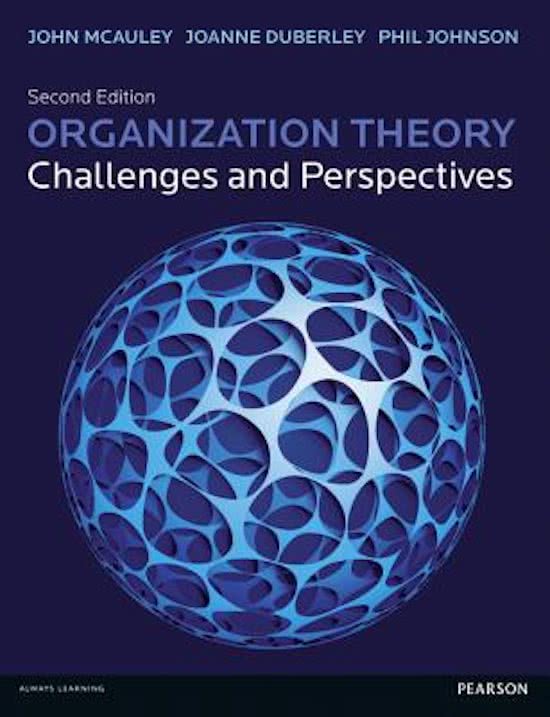Inhoudsopgave
1. Lecture 4: .............................................................................................................................................. 2
2. Lecture 5: .............................................................................................................................................. 7
3. Lecture 6: ............................................................................................................................................ 11
4. Lecture 7: ............................................................................................................................................ 13
5. Lecture 8 ............................................................................................................................................. 18
6. Lecture 9 ............................................................................................................................................. 22
, 1. Lecture 4:
Neo-modernists reject the idea that people only work in organization for economic reward.
They believed that they also worked for things like individual satisfaction, group
memberschip, belonging to an organization and having a say in the organization.
Neo-modernist: applied approaches and methodologies of social sciences to organizations
(psychology, sociology, anthropology)
But still modernist: Organization is the key element to human activity.
They just look at the world differently and have different ideas on what reality consist of
when it comes to organization (ontology) and have different kind of methods that could be
used to discover the truth (epistemology)
Conclusions modernist perspective:
Focus on rationality: effectiveness, efficiency, legality
Positivist: looked at objective facts, measurements, logic, technocratic (people tried to
develop new technologies to organize things)
By developing new technologies they first focused on:
*‘’principles’’ (hierarchy, commands, rules)
*Then advances with contingency and systems theories
Basically in this new perspective they still try to do this, but it will become more difficult
The hawthorne studies: 1920 – 1930
- Started from a scientific management perspective (Started with ideas in the line of
Taylor).
- They looked at all kind of things in an organization that could be changed in order
to increase productivity. Were about more down to earth aspects.
• Lightning
• Sleep
• Piece rate wages
- The researchers could not come up with clear interpretations, so Elton Mayo
came up with a reinterpretation in 1945.
The hawthorne effect:
“The phenomenon in which subjects in behavioral studies change their performance in
response to being observed” (Roethlisberger 1966)
Piece rate wages: Do workers produce more under piece rate wages?
Introduction:
Effects:
- Increased production
- Increased differences in individual performance (some people are more handy
and can produce more and other people can’t. Everybody work as hard as
possible. If they don’t get paid per piece, everybody works equally hard)
People were earning lots of money, more than managers. It was unwise to pay so much
money for a simple task.
Reducing pay per piece:
Effects:
- Decreased production
- Especially among the most productive employees
, They were afraid that that management would reduce the wage again.
If they do that, not only the most productive employees get a reducement, but
also the less productive employees. What mayo argued: if you look at the whole
group, the people who produce less get angry at the people who produce most,
because they reduce their wage -> corrected by the group.
They also conducted interviews with workers to compile information about workers’
attitudes about issues such as the nature of their jobs, supervision and working
conditions -> insight in invisible factors influencing human behaviour were taylor never
looked at
The bank wiring room: observation study by mayo and weber
In factory they observe what people are doing and try to understand what they are doing.
è Formal structure
è Informal structure
They also take notes about how people within groups work together
- Help eachother
- Playing games with eachother
- Fight with eachother
According to this: a new understanding of organization:
- Organizations are far more complex than modernist theories suggest:
- Organizations are social systems more than formal systems
- To understand them, we need a better understanding of human being and how
they interact
An organization chart is not an organization. It does not say anything about reality.
Maybe two departments are in conflict with each other, maybe some department is not
efficient at all and gets all the money from the top and the other departments drain from
resources, maybe a person is in love with a person in the top, and that’s why he of she
keeps their job. -> these aspects can’t be concluded from a organization chart.
Lesson from these studies: formal structure doesn’t mean so much. How people relate to
each other and form informal structures are much more important.
, Three new aspects of special interest:
1. Social grouping and informal structures
2. Human capabilities and human motivation
3. Organization culture
1. Social grouping and informal structures
- Workers may or may not want to help each other
- When someone doesn’t feel part of the team, they maybe don’t want to help
other persons.
Groups who work together to achieve goals says more than a chart.
- Workers may influence each other’s spirits
- Groups may actively support or undermine the formal organization
è People who don’t have social connection to others may drop out -> introduction
week to get to know each other.
2. Human capabilities and human motivation
Mcgregor wrote a really important essay on how traditional managers treated their
personnel and how this let to underperforming by their personnel.
Existing organization is based on conventional (taylorist beliefs):
Theory X
- Workers are dumb and lazy
- Workers lack ambition
- Workers are self-centred
- Workers resist change
This “Theory X” determines how workers treated: coercive
management, rules, supervision...
Theory X is “a self-fulfilling theory” – managers think that workers are like that and were
treated with these ideas in mind. According to this, people started to dislike this job
because the way they got threatened and they become lazy and less ambitious.
According to this, McGregor developed theory Y:
Theory Y:
Is the opposite as theory x
- People like to be productive -> intrinsic motivation (sports)
- People have skills (people developed skills by going to school for several years)
- People like to learn
- People like to take on responsibilities.
This new theory calls for a new management style:
- A different attitude -> treat them different than before to let people feel like this.
- Involve the employee: make sure that the work they do connects to their needs.
People like the work and get intrinsic motivation and get motivation by the work. If
people can do things, they like to show that, so you have to involve their skills.
- As a manager you have to:
• Remove obstacles (division of labour)
• Provide guidance (learn how to do things)
• Encourage personal growth (feel good about themselves when they achieve
new things)
3. Organizational culture:
People in organizations develop a shared understanding






